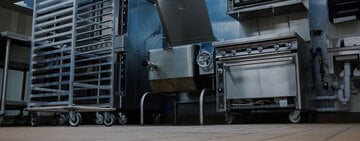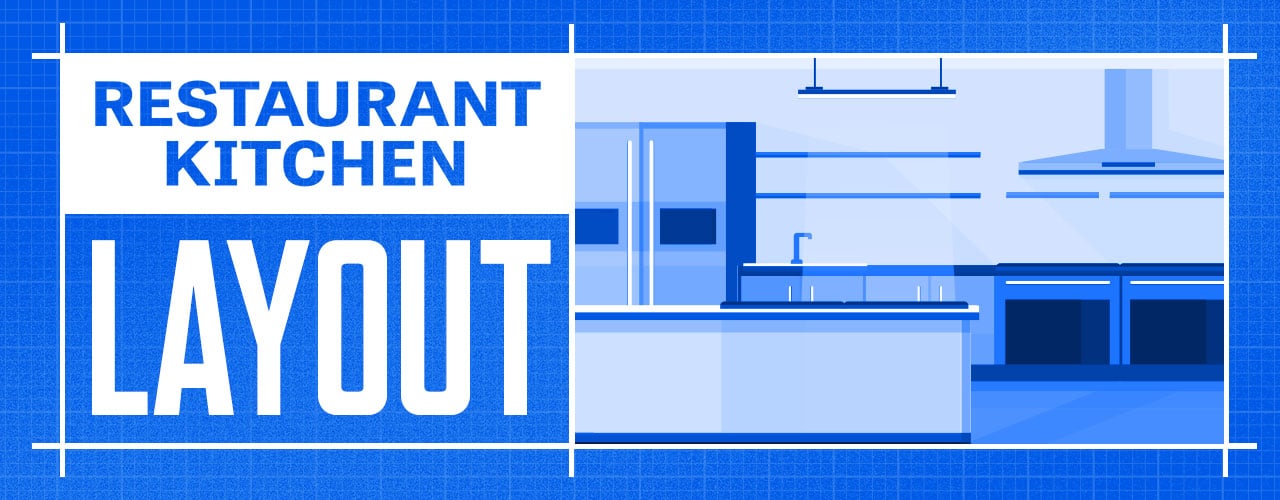
The layout of a restaurant kitchen plays a crucial role in an establishment's overall efficiency and success. A well-designed kitchen layout can significantly enhance the workflow, minimize bottlenecks, and improve the staff's production. Below, we’ll outline the factors you need to consider to create a kitchen layout that maximizes productivity and ensures a smooth operation for all.
Components of a Commercial Kitchen
Most people hear "commercial kitchen" and think of ranges, grills, and fryers. That may be the case, but the true commercial kitchen is much more than just the equipment or personnel found in it. A successful kitchen includes specific components organized in a particular pattern to optimize performance and efficiency. Additionally, some restaurants may set up their kitchen a certain way to match their establishment's concept or design. Regardless of the style or layout, all commercial kitchens will have these components:
Cleaning/Washing
The cleaning and washing section of a commercial kitchen includes appliances and products like sinks, warewashing machines, and drying racks, among others. Three-compartment sinks are necessary for washing utensils, while warewashing machines can quickly clean plates and other serving vessels to keep the kitchen running at full speed. This section of the kitchen should be located near the kitchen entrance so servers can quickly drop off dirty dishes, and near the storage area so chefs can quickly find clean dishes.
Storage
The storage area can be split into non-food storage, cold storage, and dry storage. The non-food storage area can be split further into a section for disposable products, a section for cleaning supplies, and a section for the clean dishes from your cleaning/washing area. Remember, in order to avoid contamination, cleaning and sanitation chemicals cannot be stored above food, food equipment, utensils, dishes, or disposables.
Cold storage is where you keep anything that needs to be refrigerated or frozen, while dry storage includes all nonperishables and other consumables. This area might also contain a receiving area for inventory shipments, shortening the distance new stock has to travel through your restaurant.
Food Preparation
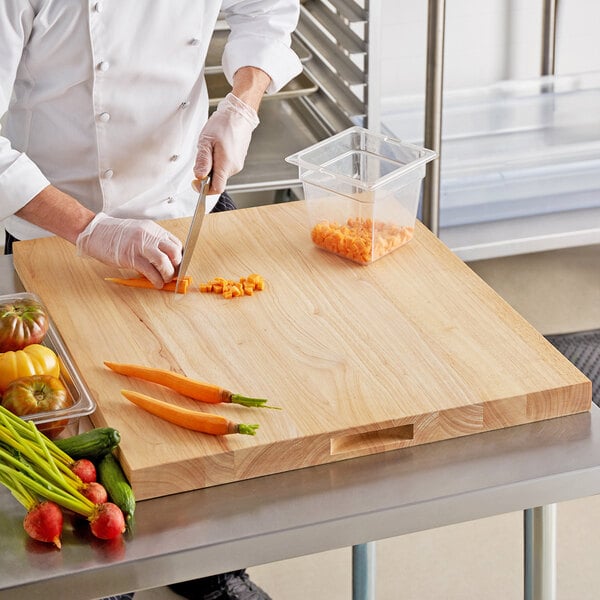
The food preparation area has sinks for washing produce, cutting areas, and mixing areas. Typically, the food preparation area is split into a section for processing raw foods (breaking down cuts of beef, for example) and a section for sorting foods into batches (chopping vegetables, mixing salad dressings, etc.). Placing this section near your storage area allows cooks to efficiently grab fresh dishes, prepare plates, and move them on to the cooking area quickly.
Meal Cooking
The meal cooking area is where main dishes are finished, so here you will have large pieces of equipment like ranges, ovens, and fryers. Like the food preparation area, the meal cooking area can be broken down into smaller sections like a baking station, grilling station, and frying station. Because meals are finished here, the meal cooking area should be near the front of the kitchen next to the service area.
Service
The service area is the final section of a commercial kitchen. If you have a serving staff, this is where they will pick up finished dishes to take to customers. If you have a self-serve or buffet-style restaurant, this is where foods will be displayed in warmers for customers to assemble their plates. This area needs to be located at the very front of the kitchen, just after the meal cooking area, to shorten the distance between completed meals and customers.
Commercial Kitchen Layout
There is no perfect formula for commercial kitchen layout. Every foodservice establishment is unique and will operate differently than others, so you have to decide what will help you best meet your kitchen goals. That said, there are several basic commercial kitchen design layouts to consider that succeed in blending solid kitchen design principles and kitchen components effectively.
Island-Style Kitchen Layout
The island-style layout places the ovens, ranges, fryers, grills, and other principle cooking equipment together in one module at the center of the kitchen, while other sections of the kitchen are placed on the perimeter walls in the proper order to preserve a circular flow (any section can be the “island” depending on what best suits your needs). This layout is very open and promotes communication and supervision, while leaving plenty of open floor space for easy cleaning. This layout works best in a large kitchen that is square in shape, but can certainly be modified to fit other shapes and sizes.
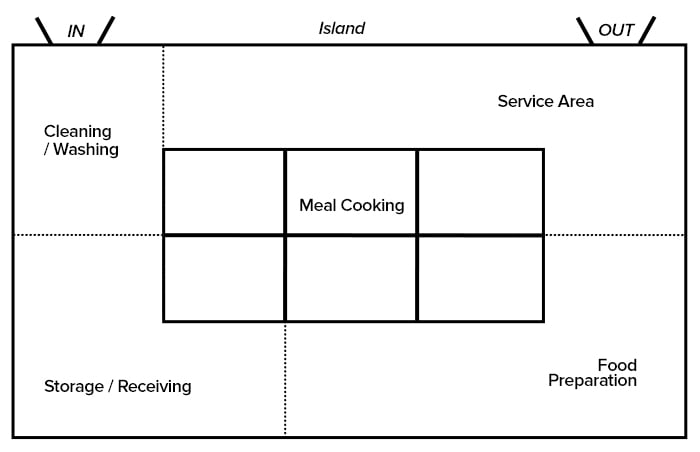
Zone-Style Kitchen Layout
The zone-style layout has the kitchen set up in blocks with the major equipment located along the walls. Again, the sections follow the proper order for increased flow, giving you a dishwashing block, a storage block, a food prep block, etc. Communication and supervision are not difficult in this layout because the center of the space is completely open.
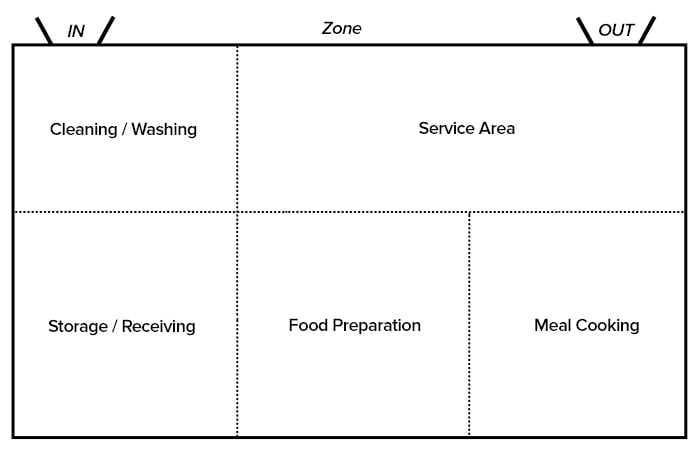
Assembly Line Kitchen Layout
The assembly-line configuration is ideal for kitchens that need to serve a large quantity of people quickly, like cafeterias or correctional facilities. This layout may work better for establishments with a limited menu that serve large quantities of the same foods, like a sandwich or pizza shop, but it is viable for any type of kitchen. In this layout, kitchen equipment is organized in a line with the food preparation area at one end and the service area at the other, allowing cooks to quickly send food down the line. The cleaning/washing and storage/receiving areas can be located behind the assembly line to keep them out of the way. This creates supreme efficiency, and keeps the kitchen open for excellent communication and flow. Often, kitchen equipment can be linked together, further eliminating wasted space.

Commercial Kitchen Design
When it comes to designing a commercial kitchen, there are several design aspects such as ergonomics and flexibility that you need to consider. A well-designed commercial kitchen not only enhances the overall functionality of the space but also plays a crucial role in the success of any food service establishment. We’ve outlined the key features your kitchen should possess in order to ensure efficiency and productivity is maximized:
- Ergonomics - By strategically placing equipment and workstations, such as prep areas, cooking stations, and storage spaces, the design can optimize workflow and reduce unnecessary movement. This not only improves productivity but also reduces the risk of accidents and injuries.
- Flexibility - A flexible kitchen layout allows for easy reconfiguration and adaptation to changes in menu offerings, business growth, and operational needs. By incorporating modular equipment and versatile storage solutions, the kitchen can easily accommodate different cooking methods and styles, making it more adaptable to evolving culinary trends.
- Sanitation - A well-designed kitchen layout should facilitate proper cleaning and maintenance to meet stringent sanitation standards. This includes incorporating smooth, easy-to-clean surfaces, adequate drainage systems, and proper ventilation to minimize the risk of cross contamination and the buildup of harmful bacteria.
- Compliance with Health Codes - The layout should adhere to local health department codes and guidelines to ensure food safety and hygiene. This includes considerations such as proper separation of raw and cooked food areas, appropriate handwashing stations, and the installation of commercial-grade equipment that meets industry standards.
- Efficiency - A well-designed layout minimizes wasted time and energy by optimizing the flow of ingredients, equipment, and staff. This includes strategically placing workstations in a logical sequence, ensuring easy access to necessary tools and ingredients, and minimizing unnecessary movement or backtracking.
- Supervision - A commercial kitchen should provide clear lines of sight for supervisors and managers to oversee kitchen operations and monitor staff performance. This can be achieved by incorporating open kitchen designs, strategically placed observation points, and clear communication channels between different areas of the kitchen.
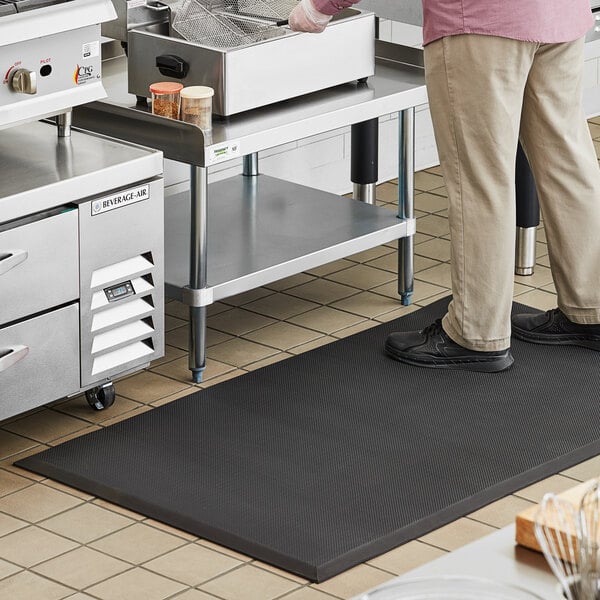
Commercial Kitchen Planning
When it comes to designing a restaurant kitchen, careful planning is essential to ensure maximum efficiency and productivity. A well-thought-out kitchen layout can streamline operations, optimize workflow, and ultimately contribute to the success of your establishment. Discover some fo the most important aspects of a commercial kitchen you should consider when planning your kitchen’s design:
Lighting
Lighting plays a crucial role in any kitchen setting, and commercial kitchens are no exception. Adequate lighting is essential to ensure the safety of your staff and the quality of your food. Bright and well-distributed restaurant lighting helps prevent accidents and enables chefs to accurately assess the color, texture, and freshness of ingredients. It is recommended to use energy-efficient LED lights, which provide excellent illumination and have a longer lifespan compared to traditional incandescent or fluorescent bulbs.
Spacing
Space optimization is a fundamental aspect of commercial kitchen planning. The layout should be designed to maximize efficiency and minimize unnecessary movement. The cooking area should be equipped with the necessary appliances and have ample space for chefs to work comfortably. The preparation area should be located close to the cooking area, allowing for easy transfer of ingredients and reducing the time spent on food preparation. Finally, the storage area should be conveniently located near the cooking and preparation areas to facilitate quick access to ingredients and supplies.
Flooring
The flooring material of a commercial kitchen should be durable, slip-resistant, and easy to clean. Given the high traffic and constant exposure to spills, grease, and heat, it is crucial to select a flooring material that can withstand these challenges. Common options for commercial kitchen flooring include quarry tile, epoxy resin, and vinyl composite tile.
Restaurant kitchen layouts are an essential aspect of any food service establishment. A well-designed restaurant kitchen layout is essential for any food service establishment's smooth and efficient operation. By considering factors such as flow, equipment positioning, space utilization, and safety, restaurant owners can create a workspace that promotes productivity and enhances the overall dining experience for their customers.





